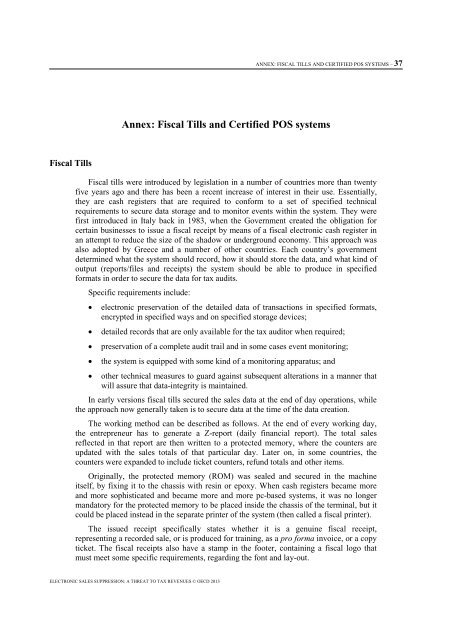ELECTRONIC SALES SUPPRESSION: A THREAT TO TAX REVENUES
ELECTRONIC SALES SUPPRESSION: A THREAT TO TAX REVENUES
ELECTRONIC SALES SUPPRESSION: A THREAT TO TAX REVENUES
Create successful ePaper yourself
Turn your PDF publications into a flip-book with our unique Google optimized e-Paper software.
Fiscal Tills<br />
<strong>ELECTRONIC</strong> <strong>SALES</strong> <strong>SUPPRESSION</strong>: A <strong>THREAT</strong> <strong>TO</strong> <strong>TAX</strong> <strong>REVENUES</strong> © OECD 2013<br />
ANNEX: FISCAL TILLS AND CERTIFIED POS SYSTEMS – 37<br />
Annex: Fiscal Tills and Certified POS systems<br />
Fiscal tills were introduced by legislation in a number of countries more than twenty<br />
five years ago and there has been a recent increase of interest in their use. Essentially,<br />
they are cash registers that are required to conform to a set of specified technical<br />
requirements to secure data storage and to monitor events within the system. They were<br />
first introduced in Italy back in 1983, when the Government created the obligation for<br />
certain businesses to issue a fiscal receipt by means of a fiscal electronic cash register in<br />
an attempt to reduce the size of the shadow or underground economy. This approach was<br />
also adopted by Greece and a number of other countries. Each country’s government<br />
determined what the system should record, how it should store the data, and what kind of<br />
output (reports/files and receipts) the system should be able to produce in specified<br />
formats in order to secure the data for tax audits.<br />
Specific requirements include:<br />
• electronic preservation of the detailed data of transactions in specified formats,<br />
encrypted in specified ways and on specified storage devices;<br />
• detailed records that are only available for the tax auditor when required;<br />
• preservation of a complete audit trail and in some cases event monitoring;<br />
• the system is equipped with some kind of a monitoring apparatus; and<br />
• other technical measures to guard against subsequent alterations in a manner that<br />
will assure that data-integrity is maintained.<br />
In early versions fiscal tills secured the sales data at the end of day operations, while<br />
the approach now generally taken is to secure data at the time of the data creation.<br />
The working method can be described as follows. At the end of every working day,<br />
the entrepreneur has to generate a Z-report (daily financial report). The total sales<br />
reflected in that report are then written to a protected memory, where the counters are<br />
updated with the sales totals of that particular day. Later on, in some countries, the<br />
counters were expanded to include ticket counters, refund totals and other items.<br />
Originally, the protected memory (ROM) was sealed and secured in the machine<br />
itself, by fixing it to the chassis with resin or epoxy. When cash registers became more<br />
and more sophisticated and became more and more pc-based systems, it was no longer<br />
mandatory for the protected memory to be placed inside the chassis of the terminal, but it<br />
could be placed instead in the separate printer of the system (then called a fiscal printer).<br />
The issued receipt specifically states whether it is a genuine fiscal receipt,<br />
representing a recorded sale, or is produced for training, as a pro forma invoice, or a copy<br />
ticket. The fiscal receipts also have a stamp in the footer, containing a fiscal logo that<br />
must meet some specific requirements, regarding the font and lay-out.


